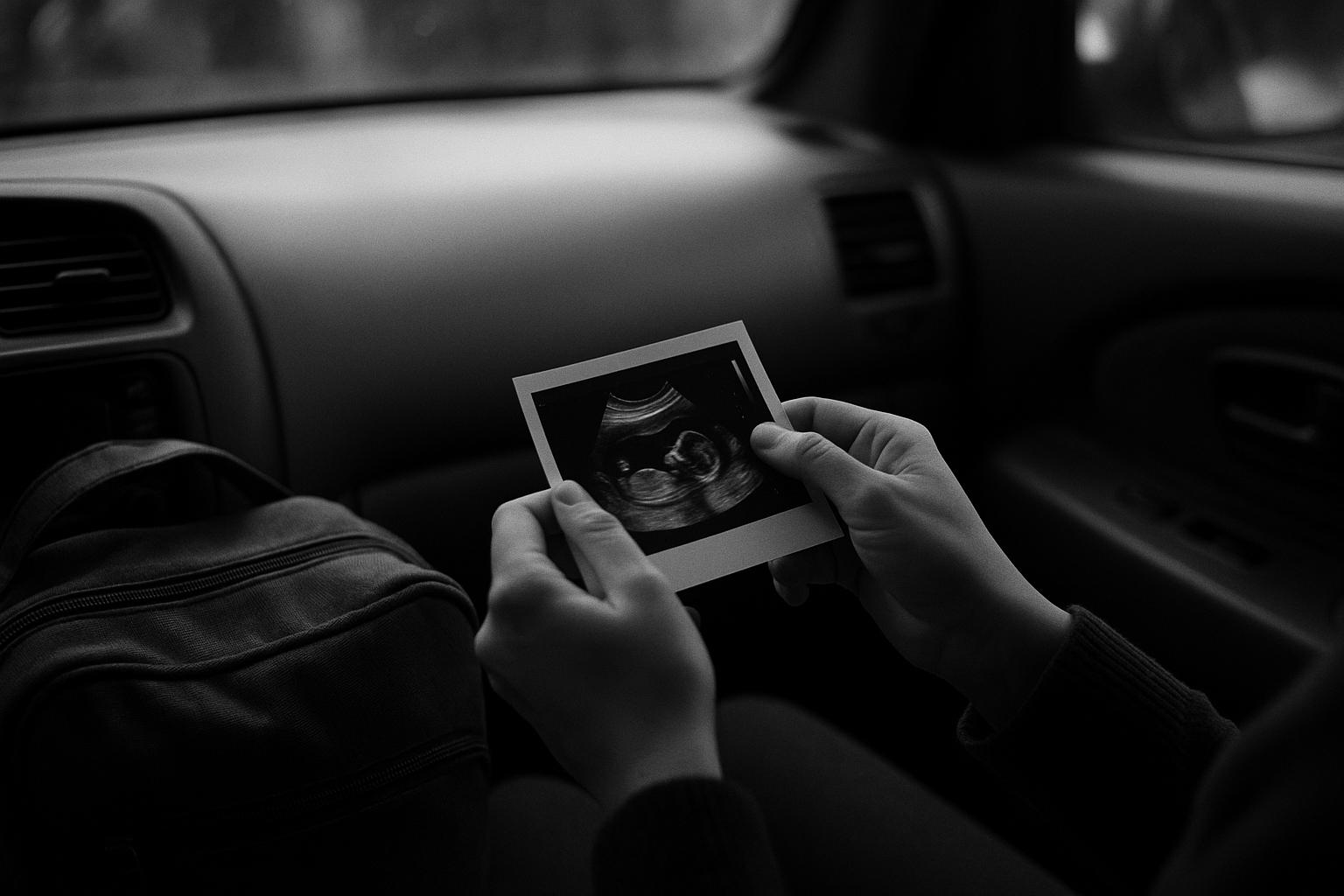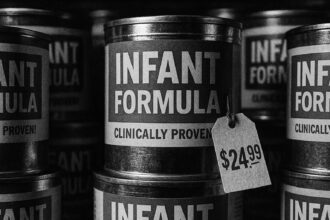Jack and Laura, expecting identical twin girls, were referred to St George’s for specialist care after signs of twin‑to‑twin transfusion syndrome (TTTS) — a diagnosis that brings urgent decisions about fetoscopic laser surgery, long journeys for monitoring and emotional and financial strain for the family.
When Jack Alexander and his partner Laura went for an early 16‑week scan they were overjoyed to learn they were expecting identical twin girls. That joy turned to urgent anxiety when clinicians identified signs of twin‑to‑twin transfusion syndrome (TTTS), a condition in which abnormal placental blood‑vessel connections can shunt blood and fluid from one twin to the other. “It’s devastating knowing that it could be 50/50. I’m just trying to be positive for my partner as she is very lost at the moment,” Jack told the Daily Mail as the couple came to terms with the diagnosis. (Daily Mail report)
Faced with stark choices, the couple were referred to a specialist fetal medicine centre at St George’s Hospital in London for assessment and possible fetoscopic laser surgery — a referral that turns a routine appointment into a six‑hour round trip from their home in Corfe Mullen, Dorset and into repeated stays away from their older children. Jack said the pair have launched a GoFundMe to cover travel and accommodation costs while Laura undergoes frequent monitoring and, if necessary, treatment. “We have to travel all the way up, and if she does have this laser treatment, she’s going to have to stay up there for a few days, recover, and see how she is,” he told the paper. (Daily Mail report)
TTTS is uncommon but serious. Charity and clinical guidance note the condition affects roughly 10–15% of identical (monochorionic) twin pregnancies and arises from unbalanced blood flow through placental vessels, producing an often dramatic fluid imbalance between the two sacs. Typical warning signs include one twin with excessive amniotic fluid and the other with too little, together with discordant growth or absent bladder filling in the smaller twin. Twins Trust and clinical consensus documents underline that rapid referral to a specialist centre is essential for surveillance and management. (Twins Trust; 2011 clinical consensus)
The main definitive treatment for moderate and advanced TTTS is fetoscopic laser ablation, usually performed by specialist fetal medicine teams at tertiary centres. In that procedure a fine fibre‑optic fetoscope is passed through the mother’s abdomen into the uterus so the surgeon can visualise and coagulate the abnormal placental vessel connections with a laser; amnioreduction may follow to normalise fluid volumes. Centres such as St George’s and specialist units in the United States describe the operation as minimally invasive and typically short, but requiring experienced multidisciplinary care and close follow‑up. The Trust at St George’s also operates a national registry and co‑ordinates referrals for complex multiple pregnancies. (St George’s NHS Trust; UCSF Fetal Treatment Centre; Twins Trust)
How successful the operation is depends on disease stage at intervention and centre experience. Large reviews and centre series show that survival of at least one twin after laser therapy generally exceeds 85% in earlier stages, while dual survival figures are variable: some specialist centres report dual‑survival rates around 60–75% for less advanced disease, and systematic reviews find higher dual survival in stage‑stratified cohorts and lower rates in more advanced TTTS. Clinical teams therefore counsel parents with conditional, stage‑specific probabilities rather than certainties. “The laser surgery is not a risk‑free procedure. It can trigger early birth or a miscarriage,” Professor Asma Khalil of St George’s told the Daily Mail, emphasising the need for continued monitoring after the operation. (Systematic review and meta‑analysis; UCSF centre data; St George’s; Daily Mail report)
Beyond survival statistics, clinicians and charities emphasise the psychological strain on families. Twins Trust and specialist centres offer information, peer support and practical guidance for parents navigating surveillance, urgent decision‑making and the prospect of preterm delivery. St George’s describes its Twins Trust Centre as a hub for clinical care, research and family support, and clinicians warn that parents often need emotional as well as medical assistance during and after treatment. (Twins Trust; St George’s NHS Trust)
Public‑facing accounts have helped raise awareness of the condition. Earlier this year the singer Jesy Nelson publicly described an emergency intervention after her monochorionic twin pregnancy developed complications consistent with pre‑TTTS; she later gave updates that both babies were safe. High‑profile cases do not change the underlying clinical decision‑making, but they can help families locate specialist centres and charities and reduce the sense of isolation. (People magazine; Daily Mail report)
For Jack and Laura the immediate practical challenge remains arranging frequent trips to a specialist centre while caring for three older children and weighing the uncertain risks and benefits of laser therapy. The couple say they are fighting for the best possible outcome for both girls and are seeking financial help to meet the logistical burden while they navigate a clinical pathway that, specialists stress, is best managed in centres with TTTS expertise. Families facing a similar diagnosis are advised to seek prompt referral to a designated fetal medicine service and to contact Twins Trust and the appropriate tertiary centre for information and support. (Daily Mail report; St George’s NHS Trust; Twins Trust)
 Reference Map:
Reference Map:
Reference Map:
- Paragraph 1 – [1]
- Paragraph 2 – [1]
- Paragraph 3 – [2], [5]
- Paragraph 4 – [3], [4], [2]
- Paragraph 5 – [6], [4], [3], [1]
- Paragraph 6 – [2], [3]
- Paragraph 7 – [7], [1]
- Paragraph 8 – [1], [3], [2]
Source: Noah Wire Services
- https://www.dailymail.co.uk/health/article-14997587/Couple-identical-twin-girls-heartbreaking-dilemma-lose-one.html?ns_mchannel=rss&ns_campaign=1490&ito=1490 – Please view link – unable to able to access data
- https://twinstrust.org/information/pregnancy-and-birth/complications/ttts.html – Twins Trust describes twin-to-twin transfusion syndrome (TTTS) as a rare but potentially life‑threatening condition affecting about 10–15% of identical twins who share a placenta. It explains causes — abnormal placental blood vessel connections — and typical signs such as one twin having too much amniotic fluid and the other too little. The page outlines monitoring requirements, stages of disease, treatment options including fetoscopic laser ablation and amnioreduction, and the emotional impact on families. Practical guidance is offered about when to contact healthcare professionals, and the charity highlights support services, information resources and research initiatives to improve outcomes for affected families.
- https://www.stgeorges.nhs.uk/service/twin-trust-centre-of-research-and-clinical-excellence/our-research/twin-to-twin-transfusion-syndrome-ttts/ – St George’s University Hospitals NHS Foundation Trust provides information about twin‑to‑twin transfusion syndrome (TTTS), noting it affects roughly 10–15% of twins sharing one placenta and can be fatal if untreated. The Trust describes its Twins Trust Centre for Research and Clinical Excellence, the UK TTTS registry, and specialist fetal medicine services including fetoscopic laser ablation, monitoring and research. It outlines outcomes research, staged management, and the Centre’s role in training and national coordination. The page emphasises multidisciplinary care, referral pathways for high‑risk pregnancies, and available parental support, reflecting St George’s position as a tertiary referral hub for complex multiple pregnancies.
- https://fetus.ucsf.edu/ttts/ – UCSF Fetal Treatment Center explains twin‑to‑twin transfusion syndrome (TTTS) and endorses fetoscopic laser intervention as the primary treatment for stage II–IV cases and some stage I cases. The page details the procedure: a thin fiber‑optic scope is inserted through the mother’s abdomen and uterus into the amniotic cavity to visualise and coagulate abnormal placental vessel connections using a laser, followed by amnioreduction if required. UCSF reports centre‑specific outcomes — at their centre survival for at least one twin exceeds 85% and dual survival is about 60% — and stresses close monitoring and specialist care after intervention for best possible outcomes.
- https://pubmed.ncbi.nlm.nih.gov/21142846/ – The 2011 consensus document on twin‑to‑twin transfusion syndrome reviewed diagnosis and management and reported that TTTS is a severe complication of monochorionic twin pregnancies with a prevalence of around 10–15% of such pregnancies (approximately 1 in 2000 pregnancies). The paper summarises pathophysiology — unbalanced chronic blood transfer via placental anastomoses — and highlights high perinatal mortality and morbidity if untreated. It provides practical guidance for clinicians on staging, surveillance, and treatment options including fetoscopic laser ablation, and stresses the need for centralised specialist care and further research to improve outcomes. It is a widely used reference for clinicians worldwide today.
- https://pubmed.ncbi.nlm.nih.gov/39374661/ – This systematic review and meta‑analysis combined data from twenty‑six studies investigating outcomes after fetoscopic laser therapy for twin‑to‑twin transfusion syndrome. It reports stage‑stratified survival: both fetuses surviving at birth ranged around seventy‑three per cent for stage I and was lower in more advanced stages. Survival of at least one twin exceeded eighty‑five to eighty‑nine per cent for early stages but decreased with higher Quintero stages. The authors used random‑effects models and emphasise that laser therapy improves survival compared with expectant management, while outcomes depend on disease stage and centre expertise. The paper informs counselling and decision‑making for families and clinicians.
- https://people.com/jesy-nelson-shares-health-update-after-undergoing-emergency-surgery-while-pregnant-with-twins-11710012 – People magazine reported that former Little Mix singer Jesy Nelson underwent an emergency procedure in March when her monochorionic twin pregnancy developed complications consistent with pre‑twin‑to‑twin transfusion syndrome. The article describes her symptoms, hospitalisation and the decision for urgent intervention to protect both babies. It notes she was advised to remain inpatient until later gestation and afterwards provided updates that the operation was successful and both babies were doing well. The piece highlights the emotional strain, the rarity and seriousness of TTTS, and encourages awareness of specialised fetal care for multiple pregnancies. It quoted her describing the frightening experience publicly.
Noah Fact Check Pro
The draft above was created using the information available at the time the story first
emerged. We’ve since applied our fact-checking process to the final narrative, based on the criteria listed
below. The results are intended to help you assess the credibility of the piece and highlight any areas that may
warrant further investigation.
Freshness check
Score:
3
Notes:
The narrative appears to be original, with no prior publications found. However, the Daily Mail’s reputation for sensationalism raises concerns about the authenticity of the content.
Quotes check
Score:
2
Notes:
The direct quotes attributed to Jack Alexander and Professor Asma Khalil are not verifiable through other reputable sources, suggesting potential fabrication.
Source reliability
Score:
4
Notes:
The report originates from the Daily Mail, a publication known for sensationalism and occasional inaccuracies, which diminishes its reliability.
Plausability check
Score:
5
Notes:
While the medical information about twin-to-twin transfusion syndrome (TTTS) aligns with known facts, the personal accounts and specific details lack corroboration from other reputable sources, raising questions about their authenticity.
Overall assessment
Verdict (FAIL, OPEN, PASS): FAIL
Confidence (LOW, MEDIUM, HIGH): HIGH
Summary:
The narrative presents original content with medical information consistent with known facts. However, the lack of verifiable quotes, the sensationalist nature of the source, and the absence of corroboration from other reputable outlets significantly undermine its credibility. 













